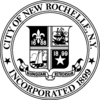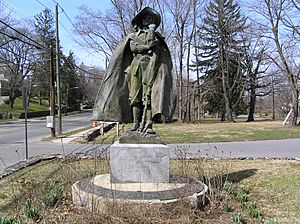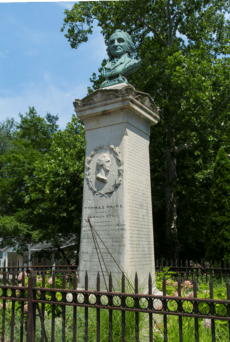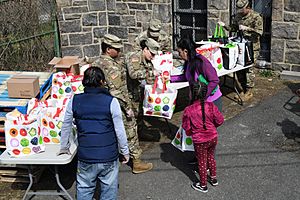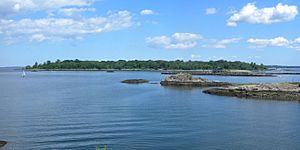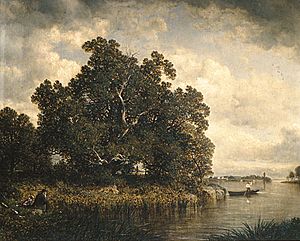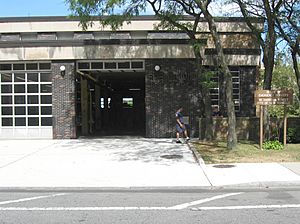New Rochelle, New York facts for kids
Quick facts for kids
New Rochelle, New York
|
|||||
|---|---|---|---|---|---|
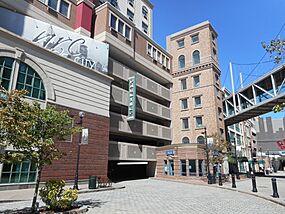
New Roc City and New Rochelle police station
|
|||||
|
|||||
| Nickname(s):
Queen City of the Sound
|
|||||
| Motto(s):
Nunquam Retrorsum
(Never Backward) |
|||||
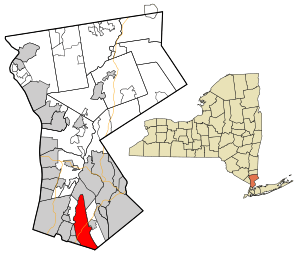
Location within Westchester County and the state of New York
|
|||||
| Country | |||||
| State | |||||
| County | Westchester | ||||
| Incorporated (city) | 1899 | ||||
| Named for | La Rochelle, France | ||||
| Government | |||||
| • Type | Council-Manager | ||||
| Area | |||||
| • Total | 13.14 sq mi (34.05 km2) | ||||
| • Land | 10.29 sq mi (26.64 km2) | ||||
| • Water | 2.86 sq mi (7.40 km2) | ||||
| Elevation | 85 ft (26 m) | ||||
| Population
(2020)
|
|||||
| • Total | 79,726 | ||||
| • Density | 7,750.92/sq mi (2,992.62/km2) | ||||
| Time zone | UTC−5 (Eastern (EST)) | ||||
| • Summer (DST) | UTC−4 (EDT) | ||||
| ZIP Codes |
10801–10802, 10804–10805
|
||||
| Area code(s) | 914 | ||||
| FIPS code | 36-50617 | ||||
| GNIS feature ID | 958451 | ||||
New Rochelle is a city in Westchester County, New York, United States. It is a suburb of New York City, located about 17 miles (27 km) from Midtown Manhattan. In 2020, the city had a population of 79,726 people. This makes it the 7th-largest city in New York State.
Contents
History of New Rochelle
Early Days: 17th and 18th Centuries
For thousands of years, Native American groups lived in this area. They used the rich resources of Long Island Sound and the land. By the 1600s, the Lenape people were important in the area. Their land stretched from Connecticut to Delaware.
In 1654, the Siwanoy Indians, a Lenape group, sold land to an English settler named Thomas Pell. In 1688, about 33 families started a community called La Nouvelle-Rochelle. Many of these families were skilled workers from La Rochelle, France.
A monument in Hudson Park lists the names of these early settlers. This park was where the Huguenots first landed. In 1689, Pell officially gave 6,100 acres (25 km2) for this new French community.
Jacob Leisler was an important person in early New Rochelle. He was a rich merchant in New York. He helped the Huguenots when he was acting-governor of the province.
One rule of the land sale was that Pell and his family would get "one fatt calfe" every June 24th if they asked for it. This "fatt calfe" was even shown on a special coin in 1937. Sometimes, there are still "fatt calfe" ceremonies today.
New Rochelle was one of the few French colonies in America that truly stayed French. French refugees kept coming until 1760. People in nearby areas often sent their children to New Rochelle to learn French.
In 1775, General George Washington visited New Rochelle. He was on his way to lead the American Army. In 1776, the British Army briefly took over parts of New Rochelle. After a battle, New Rochelle became a "Neutral Ground" for Washington's troops to rest.
After the American Revolutionary War ended in 1784, Thomas Paine received a farm in New Rochelle. He was a patriot who helped America gain independence. The farm was about 300 acres (1.2 km2).
The first national census in 1790 showed New Rochelle had 692 residents. This included 136 African Americans. Some were free, and others were enslaved.
Growth and Change: 19th and 20th Centuries
New Rochelle was a quiet farming village in the 1700s. But in the 1800s, many people moved to New York City. Some families then moved from the city to New Rochelle. The original French families still had a lot of power in the town.
By 1820, 150 African Americans lived in New Rochelle. Six of them were still enslaved. New York State slowly ended slavery. All enslaved people were freed by 1827.
In 1857, the Village of New Rochelle was created. The first fire service started in 1861. In 1899, New Rochelle officially became a city. Michael J. Dillon became the city's first mayor.
By 1900, New Rochelle had 14,720 people. Farms and large homes were bought for new neighborhoods. Rochelle Park was one of the first planned communities in the country. This earned New Rochelle the nickname "City of Homes."
In 1909, Edwin Thanhouser started Thanhouser Film Corporation. His movie Million Dollar Mystery was one of the first movie series. In 1923, New Rochelle resident Anna Jones became the first African-American woman to become a lawyer in New York State.
In 1930, New Rochelle's population grew to 54,000. In the 1930s, New Rochelle was one of the wealthiest cities in New York.
By the end of the 1900s, the Metro North train station was rebuilt. A large entertainment complex called New Roc City was also built. It has a movie theater, an IMAX theater, an ice-hockey arena, mini-golf, go-karts, an arcade, restaurants, and a hotel. This complex was built where the old New Rochelle Mall used to be.
Modern Times: 21st Century
In 2014, New Rochelle approved plans for new developments. These plans included restaurants, stores, hotels, and entertainment areas. They also included a new waterfront area. These projects were planned to be finished within 10 years.
In March 2020, New Rochelle became an early center for COVID-19 in New York State. Governor Andrew Cuomo ordered a special "containment area" around a synagogue. This was to help stop the virus from spreading.
This area included parts of New Rochelle and a nearby town. It was the first time New York State closed schools and places of worship to fight the pandemic. National Guard troops helped by delivering food and cleaning public places.
Historic Places to Visit
New Rochelle has many interesting historic sites:
- Columbia Island – A small island that used to have a radio transmitter.
- Execution Rocks Lighthouse – A lighthouse built in 1849. Its name comes from the dangerous rocks nearby, not from executions.
- Huckleberry Island – A 10-acre (0.04 km2) island important for nesting birds.
- Leland Castle – A 19th-century castle. It was once a summer home and is now an art gallery.
- St. John's Wilmot Church – A historic church in the northern part of the city.
- Thomas Paine Historical Site – This site includes the home of patriot Thomas Paine. It also has his burial site, a monument, and a museum. The cottage was built in 1793.
- Trinity-St. Paul's Episcopal Church – This church was added to the National Register of Historic Places in 2006. It was founded by the Huguenot French congregation.
Geography and Location
New Rochelle is in the southeastern part of New York State. It is on the Long Island Sound. It shares borders with Pelham, Pelham Manor, Eastchester, Scarsdale, Mamaroneck, and Larchmont. The city is about 2 miles (3.2 km) north of New York City.
New Rochelle has a total area of 13.2 square miles (34.3 km2). It is shaped like a triangle. It is about 10 miles (16 km) from north to south. At its widest, it is about 1.5 miles (2.4 km) from east to west.
People of New Rochelle (Demographics)
| Historical population | |||
|---|---|---|---|
| Census | Pop. | %± | |
| 1790 | 692 | — | |
| 1820 | 1,135 | — | |
| 1830 | 1,274 | 12.2% | |
| 1840 | 1,816 | 42.5% | |
| 1850 | 2,458 | 35.4% | |
| 1860 | 3,519 | 43.2% | |
| 1870 | 3,915 | 11.3% | |
| 1880 | 5,276 | 34.8% | |
| 1890 | 9,057 | 71.7% | |
| 1900 | 14,720 | 62.5% | |
| 1910 | 28,867 | 96.1% | |
| 1920 | 36,213 | 25.4% | |
| 1930 | 54,000 | 49.1% | |
| 1940 | 58,408 | 8.2% | |
| 1950 | 59,725 | 2.3% | |
| 1960 | 76,812 | 28.6% | |
| 1970 | 75,385 | −1.9% | |
| 1980 | 70,794 | −6.1% | |
| 1990 | 67,265 | −5.0% | |
| 2000 | 72,182 | 7.3% | |
| 2010 | 77,062 | 6.8% | |
| 2020 | 79,726 | 3.5% | |
| U.S. Decennial Census | |||
In 2020, 79,726 people lived in New Rochelle. The city is very diverse. About 44.4% of residents were White. About 18.9% were Black, and 4.9% were Asian. About 32.9% of the population was Hispanic or Latino.
In 2000, the median age in New Rochelle was 37 years old. About 24% of the population was under 18. Many people in New Rochelle have gone to college. About 19,312 residents were in school.
Most people in New Rochelle work in management or sales. The average daily commute is about 30 minutes. Many people drive to work, but some use public transportation.
Homes and Neighborhoods
New Rochelle has many different types of homes. The downtown area has apartments and high-rise buildings. The rest of the city has many single-family houses. There are over 11,500 single-family homes in New Rochelle.
The city has homes built from the 1700s to today. You can see many different architectural styles. New Rochelle has many established neighborhoods. Some are larger than nearby villages.
Economy and Business
New Rochelle has been home to many different businesses. These include film studios like Thanhouser Film Studios and Terrytoons Studios. Other businesses made diners or drinks.
Today, New Rochelle is still a business center. It is home to the main offices of companies like Sidney Frank Importing and Blimpies.
Parks and Fun Activities
Waterfront Fun
New Rochelle has a beautiful shoreline on Long Island Sound. It is about 2.7 miles (4.3 km) long. But with all its curves and islands, the actual waterfront length is about 9.3 miles (15 km).
Many yacht, sailing, and rowing clubs are along the coast. Beach clubs are on Davenport Neck. The city also has a large marina for boats.
City Parks
New Rochelle has many parks and nature preserves. There are 231.51 acres (0.94 km2) of public park lands.
- Glen Island – This park was once a theme park in the 1800s. It had a zoo and a German beer garden. Today, it is a 105-acre (0.42 km2) island park. It has a beautiful beach on Long Island Sound.
- Five Islands Park – This park has several islands connected by bridges. It offers playgrounds, sports, hiking, and camping.
- Hudson Park – This 13-acre (0.05 km2) park is along the city's harbor. It has a beach, a boathouse, and yacht clubs. It is believed to be where the Huguenot settlers first landed.
- Davids Island – This 78-acre (0.32 km2) island was once a military base. Now, it is becoming a park and nature preserve. It is home to many plants, birds, and animals.
- Ward Acres – Located in the North End, this preserve has forests, meadows, and hiking trails. It used to be a horse farm. It also has a fenced-in dog park.
- The Leatherstocking Trail – A 2-mile (3.2 km) hiking trail between New Rochelle and Mamaroneck. It connects to other parks.
- Sheldrake Lake – This 60-acre (0.24 km2) park used to be a water reservoir. Now, it is a nature preserve.
- Twin Lakes Park – This park, along with Nature Study Woods, has 220 acres (0.89 km2) of woods, marshes, and lakes.
Golf and Tennis
- Wykagyl Country Club – A highly-rated golf course in the Wykagyl section of New Rochelle.
- Pelham Country Club – A golf course located near the border of New Rochelle and Pelham Manor.
- New Rochelle Tennis Club – One of the oldest tennis clubs in the country.
Education in New Rochelle
Public Schools
The City School District of New Rochelle serves the city. It has one public high school, two middle schools, six elementary schools, and one early childhood center. The city's schools have won the Blue Ribbon Award seven times. New Rochelle High School is very diverse. Students from over 60 countries attend the school. It offers many different courses.
The New Rochelle Public Library System provides library services.
Private Schools
- Hudson Montessori – A private school for young children.
- Iona Preparatory School – A Catholic school for boys from kindergarten to 12th grade.
- Mount Tom Day School – A private day school for young children.
- The Thornton Donovan School – A school for both boys and girls.
- The Ursuline School – A Catholic school for girls from sixth to 12th grade.
- Salesian High School – A Roman Catholic high school for boys.
Colleges and Universities
- Iona University – A Catholic college.
- Mercy College – Has a campus in New Rochelle.
- Monroe College – Offers professional and business education.
City Services and Transportation
Getting Around: Roads and Transit
Major highways in New Rochelle include Interstate 95 and the Hutchinson River Parkway. Interstate 95 is the main route through the city. The Hutchinson River Parkway is for passenger cars only.
The Boston Post Road is also a major road. It is called Main Street in downtown New Rochelle.
The city has a train station. It is served by Metro North and Amtrak. The Bee-Line Bus System provides local bus service. Adirondack Trailways offers bus service to other states.
Train service started in New Rochelle around 1848. Later, more railroads were built. However, some of these lines did not have enough riders and closed down.
Air Travel
Westchester County Airport serves the area. New Rochelle is also close to New York City airports. These include JFK and LaGuardia.
Emergency Services
Fire Department
The New Rochelle Fire Department (NRFD) provides fire protection and emergency medical services. They respond to about 8,000 emergency calls each year. The city also uses a private ambulance service for medical emergencies.
The NRFD has five fire stations around the city. They have five engines, three ladders, and other special vehicles.
Police Department
New Rochelle formed its first professional police department in 1885. Today, the department has 186 sworn officers. They also have over 250 total staff members. The department is known for its community policing programs. These include the 'Police and Community Together' (PACT) program.
Famous People from New Rochelle
Sister City
New Rochelle has a "sister city" in France. It is La Rochelle, France. The two cities have had a friendly relationship since 1910.
Images for kids
-
New Roc City and New Rochelle police station
See also
 In Spanish: New Rochelle para niños
In Spanish: New Rochelle para niños



